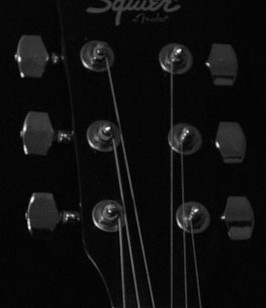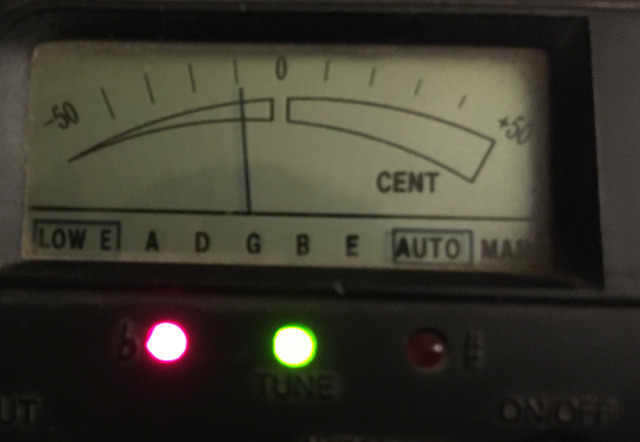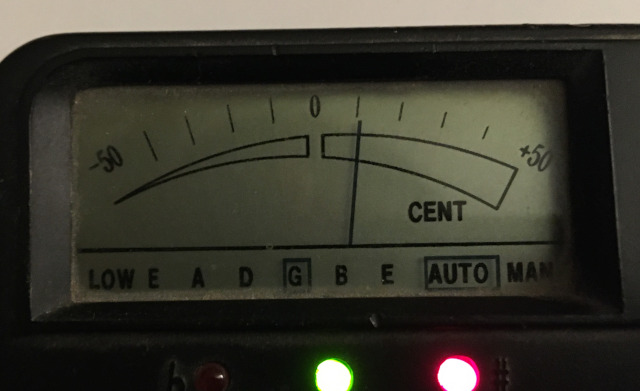Learning how to tune a guitar can be frustrating for beginners.
Often, it can feel confusing, and you might be afraid of doing some damage if you do it wrong. No problem, today you’ll learn how to tune a guitar like an old pro.
If you’re looking for easy guitar tuning, or you’re beginner guitar level, you definitely need a tuner.
Nowadays, you can just get on the internet and hit up a site for tuning, but we’ll cover tuning with a tuner, and without a tuner.
A couple words before we dive in: Don’t be afraid of breaking a guitar string!
The first time I tuned a guitar, I broke the high E string. It wasn’t the end of the world. (When I was younger, I had a girlfriend who broke the high E string on her guitar the first time she played it, and it hit her in the eye!)
At some point, no matter what, you will break a guitar string. Everybody does it, and it’s often a right of passage for guitar players.
Having said that, go slowly, and be cautious, but don’t be afraid. Now, let’s start with the basics.
How to Tune a Guitar for Beginners: The Basics
First of all, let’s get familiar with your guitar tuning knobs, also known as tuning keys. They’re usually on the headstock of your guitar.

Strike a string, and then slowly turn the tuning key for that string in one direction, and then the other. Notice that when you turn it one way the string tightens and goes sharp. When you turn it the other way, the string loosens and goes flat.
Remember to turn the tuning keys slowly especially while you’re getting familiar with this process. After a while you’ll automatically know whether to tighten or loosen a string just by listening to it.
How to Tune a Guitar for Beginners: With a Tuner
Okay, so now you’re familiar with how to change the pitch of your strings by tightening and loosening. Now get your tuner out, and turn it on. If it’s a clip-on, clip it to the headstock of your guitar, otherwise place it where you can see it comfortably.
All tuners will have some type of “feedback mechanism,” usually a needle indicator and/or red and green lights.
If your indicator is to the left of center(zero on this tuner), your string is too loose. This means your notes will be flat.

If your indicator is to the right of center(zero on this tuner), your string is too tight. This means your notes will be sharp.

How do we fix this? We’ll keep this very basic.
- Turn on your tuner, and strike the low E string(the thickest string on your guitar.)
- Read what the tuner outputs:
- If the needle is to the left of center, the string is flat. Slowly turn the tuning key for the low E until the string is tight enough to be in tune.
- As you slowly turn the tuning key, strike the string so the note keeps ringing out. Watch the readout as it slowly moves to center.
- If the needle is to the right of center, the string is sharp. Slowly turn the tuning key so that it loosens enough to be in tune.
- As you slowly turn the tuning key, strike the string so the note keeps ringing out. The indicator will move to the left as your get closer to in tune.
- A needle that is centered means the string is in tune.
- Once your low E string is in tune, repeat the process with your next thickest string(the A string.)
How to Tune a Guitar for Beginners: Without a Tuner
This is where tuning by ear comes in. You may get super accurate this way, but it’ll get you in the ball park if you don’t have a tuner, and you need to do this manually. This works on the fact that you can use one string to tune the other strings.
Generally, you need to tune at least one string to a known note, either using a piano, or a pitch pipe, or the note from a song even. If you can’t do this, just tune to one string(I usually choose low E.)
You won’t be in tune according to a tuner, but each string will be in tune with the other strings, which means all your chords will sound in tune.
Here’s a guide to help you out:
- The 5th fret of the low E is the same note as the A string
- 5th fret of the A strings is the same note as the D string
- The note of the 5th fret of the D is the G string
- The 4th fret of the G is the B string
- Finally, 5th fret of the B is the high E string
So how do we use this information?
Easy! If you put your finger on the 5th fret of the low E string, and pluck, the note you’re playing is A. Here’s the key: It’s the same A you’d hear if you plucked the 5th string and it was already in tune. So:
- Place your finger on the 5th fret of the low E string.
- Pluck the low E, with the note fretted, a few times so you’re familiar with the sound.
- Now, pluck the next string, the A string, and compare. Pluck one after another, or both at the same time, and compare the sounds.
- Do this a few times so you’ll hear how out of tune the A string is compared to the fretted E string.
- Now, turn the tuning key, slowly, either tightening, or loosening, while still plucking both strings and letting them ring out, until they’re both making the same sound.
- Repeat by fretting the A string at the 5th fret, and comparing that note with note you get when plucking the D string.
- Repeat for the next string, until you reach the B string. You’ll need to fret the 4th fret to get B, but other than that it’s the same process.
Tuning Your Guitar FAQ
Tuning your guitar may seem difficult, and intimidating at first, but with practice it’ll get easier. As time goes on, you’ll be able to tell if your guitar is out of tune, or in tune by ear.
Once your guitar is in tune, try playing each string and letting them ring out. Listen to each note, and listen to how it sounds while playing the other open strings. It sounds weird, but with practice you’ll be able to tell when one string is out of tune without even thinking about it.
- How Do I Tune an Electric Guitar?
- Tuning an electric guitar is the same process. The tuning keys on the headstock may just be placed differently.
- How Do I Use an App to Tune My Guitar?
- Same as if you were using a tuner
- What about alternate tunings?
- Same process, altough you wanna be extra careful if you’re tuning up to a note, since the tension will be higher than the string was intended for.
- What about guitar strings?
JT currently resides in Southern California and has been playing the guitar since he was 13. He enjoys baking French pastries, drinking loose-leaf tea, and running Slackware Linux.


